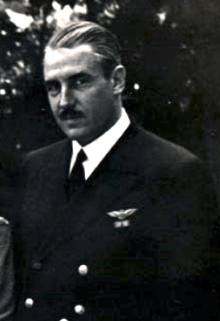Alfred Easton Poor
| Alfred Easton Poor | |
|---|---|
 | |
| Born |
May 24, 1899 Baltimore, MD |
| Died |
January 13, 1988 (aged 88) New York, NY |
| Nationality | American |
| Alma mater |
Harvard University, A.B., 1920 University of Pennsylvania, B. Arch., 1923; M. Arch., 1924 |
| Occupation | Architect |
| Buildings |
Jacob K. Javits Federal Building James Madison Memorial Building, US LIbrary of Congress |
| Projects | Wright Brothers National Memorial |
Alfred Easton Poor (May 24, 1899 – January 13, 1988) was an American architect who was involved with many buildings and projects in New York City as well as multiple works in Washington, D.C. for the US Federal Government. In 1928 he won an open competition to design the Wright Brothers National Memorial.
While a student at the University of Pennsylvania, he studied under Paul Philippe Cret.[1][2] Poor was the president of the National Academy of Design in New York from 1966 to 1977, organizing its 150th anniversary in 1975.[3] He has been called "one of America's most prominent twentieth century architects"[1] and a "prominent member of the international school of modern architecture."[4]
Projects
Over his long career, Poor's projects include both public and private sector works. Along with fellow New York architect Robert P. Rogers, Poor won the open international design competition for the Wright Brothers National Memorial in 1928.[1][2][3]
For the US Government, he worked on a project that restored and extended the East Front of the US Capitol building in the early 1960s,[1][3] and was also a leading architect in designing the US Library of Congress' James Madison Memorial Building,[3][5] the third-largest public building in Washington.[5]
Poor was especially active in the New York City area. His projects include the Jacob K. Javits Federal Building,[3][6] the Queens County Courthouse and prison in Kew Gardens,[3][7] the Home Insurance Company Building,[8][9] and the 40-acre Red Hook housing projects.[3]
Poor was chosen by Walter Annenberg to design the Annenberg School for Communication at the University of Pennsylvania.[1][10]
According to his obituary in the New York Times, he also "designed dozens of branch offices in Manhattan and abroad for the Chemical, National City and Marine Midland banks" and "designed a number of Long Island country homes."[3] Other works include the Cape Cinema, in Dennis, Massachusetts.[11]
Books
Poor was also an author of books about historical architecture, such as Formal Design in Minor French Buildings - The Tuileries Brochures (1931) and Colonial Architecture of Cape Cod, Nantucket and Martha's Vineyard (1932).[1]
Personal life
Alfred Easton Poor was a son of Charles Lane Poor. He served in the US Navy in World War I and in the US Navy Reserve in World War II.[12]
References
- 1 2 3 4 5 6 Art of the Print
- 1 2 Library of Congress, American Treasures
- 1 2 3 4 5 6 7 8 Obituary, New York Times
- ↑ Art History 3401, University of Minnesota
- 1 2 Library of Congress
- ↑ New York Architecture - Jacob K. Javits Federal Office Building
- ↑ NYC.gov Website
- ↑ In-Arch.net
- ↑ A View on Cities
- ↑ University of Pennsylvania: An Architectural Tour. By George E. Thomas and Lewis Tanner
- ↑ Cape Cinema, About
- ↑ Social Networks and Archival Context Project